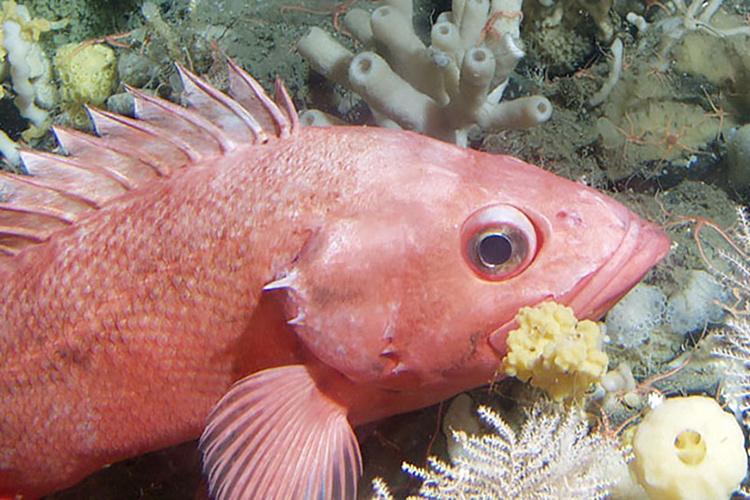Growing slowly and reproducing late in a long life is an evolutionary strategy that helped rockfish survive environmental changes over thousands of years. It also makes them more vulnerable to overfishing. Careful management based on accurate scientific information is key to keeping Alaska rockfish populations healthy.

Pacific Ocean Perch.
Surveys
Currently, 33 species of rockfish are recognized in Alaska waters. We collect information on the number, age, length, weight, and biology (such as maturity and genetics) of many of these rockfish species during bottom trawl and longline surveys in the Bering Sea, Aleutian Islands, and Gulf of Alaska. Additional information on rockfish distribution, abundance, and preferred habitat is collected using acoustic technology. These survey data are combined with information collected by fishery observers to manage the rockfish stocks in Alaska.
Habitat
True to their name, most rockfish live near the seafloor in rocky areas or are associated with living structures such as corals and sponges. We conduct studies to identify essential rockfish habitat in Alaska. Because of their affinity for rocky or structured habitat, rockfish have historically been difficult to survey. Bottom-trawl surveys are the main source of fishery-independent data for assessing fish stocks in Alaska, but bottom trawls cannot sample the steep, rocky habitats that many rockfish prefer. We are leading research on surveying untrawlable habitats using large-scale acoustics and underwater cameras.

Dusky Rockfish.
Age and Growth
Knowing the age of fish in a population is needed for assessing and forecasting populations so that sustainable catch limits can be determined. We determine the age of individual fish by counting growth rings on their otoliths (ear bones). We also develop aging criteria for species that are difficult to age such as northern rockfish, Pacific ocean perch, rougheye rockfish, and shortraker rockfish. For example, we can validate ages by analyzing the concentration of the Carbon-14 isotope released into the atmosphere and ocean by nuclear warheads exploded during the cold war that was later absorbed into otoliths. Knowing the age of rockfish also helps us investigate changes in growth, maturity, and body condition over time that may be connected with a changing climate.

Pacific Cod.
Reproduction and Maturity
Understanding the reproductive biology of different species, or how many rockfish are spawning as they age, is essential for effective management of Alaska rockfish. Rockfish have very complex reproductive strategies to increase the chances that their young will survive. The strategy used varies by species, location, and environmental conditions. Generally, rockfish are live bearers (protecting their young during early stages of development) and first participate in spawning at older ages than many other fish species.
In some rockfish species there can be increased productivity with age, meaning that older fish produce offspring that are stronger. Other rockfish species may skip spawning in a certain year to save energy for more productive years. We conduct research on how different rockfish species use these reproductive strategies in a changing environment and provide this information for managers to help maintain our healthy rockfish populations.
Barotrauma
Similar to getting the bends when scuba diving, rockfish often suffer internal injuries from air expansion when brought to the surface quickly (called barotrauma). Because of this, many rockfish released at the surface do not survive. There is some evidence that putting the fish back under pressure (recompression) may greatly increase the survival of barotrauma-injured rockfish. Because of barotrauma, it is extremely difficult to tag rockfish, which is an important technique for assessing abundance and estimating movement. Scientists have conducted research on different rockfish species to gauge the impacts of barotrauma and potential for survival using different recompression methods so that tagging might be possible.
Assessing Past, Present, and Future Rockfish Stocks
We collect and analyze the best available scientific information concerning the past, present, and possible future health of Alaska rockfish populations and present the results in annual Stock Assessment and Fishery Evaluation (SAFE) reports. These reports provide information to the North Pacific Fishery Management Council to determine annual harvest levels, document significant trends or changes in the resource, marine ecosystems, and fishery over time, and evaluate the success of existing state and Federal fishery management programs. In these reports, we compile information on the biology, distribution, stock structure, fishery, population dynamics, and management of both commercially valuable stocks such as Pacific ocean perch and many other ecologically valuable rockfish stocks. Rockfish management in Alaska has been successful at setting sustainable fishing quotas by following scientific advice.

